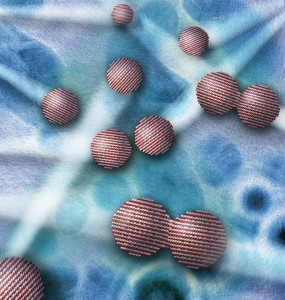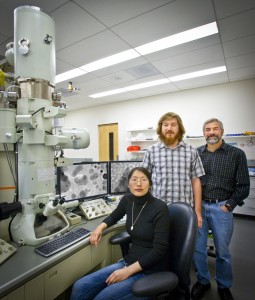This electron microscopy movie shows the early stage of nanocrystal growth. Nanoparticles make transient contact at many points and orientations until their lattices are perfectly matched. The particles then make a sudden jump-to-contact to form attached aggregates. (Movie courtesy of Jim DeYoreo)
Through biomineralization, nature is able to produce such engineering marvels as mother of pearl, or nacre, the inner lining of abalone shells renowned for both its iridescent beauty and amazing toughness. Key to biomineralization is the phenomenon known as “oriented attachment,” whereby adjacent nanoparticles connect with one another in a common crystallographic orientation. While the importance of oriented attachment to biomineral properties long has been recognized, the mechanism by which it occurs has remained a mystery. With a better understanding of oriented attachment it should be possible to synthesize new materials with remarkable structural properties. To that end, a team of researchers with the U.S. Department of Energy (DOE)’s Lawrence Berkeley National Laboratory (Berkeley Lab) have reported the first direct observation of what they have termed “jump-to-contact,” the critical step in oriented attachment.
“The direct observation of the translational and rotational accelerations associated with the jump-to-contact between nanoparticles enabled us to calculate the forces that drive oriented attachment,” said Jim DeYoreo, a scientist with the Molecular Foundry, a DOE nanoscience center at Berkeley Lab where this research took place. “This gives us a basis for testing models and simulations that could open the door to using oriented attachment in the synthesis of unique new materials.”
DeYoreo is the corresponding author of a paper in the journal Science that describes this research titled “Direction-specific interactions control crystal growth by oriented attachment.” Co-authoring this paper were Dongsheng Li, Michael Nielsen, Jonathan Lee, Cathrine Frandsen and Jillian Banfield.

Berkeley Lab researchers at the Molecular Foundry have elucidated important mechanisms behind oriented attachment that drives biomineralization and the growth of nanocrystals. (Image from Jim DeYoreo)
Ever since a study in 2000 led by co-author Banfield revealed the existence of nanoparticle oriented attachment, it has become widely recognized that the phenomenon is an important mechanism of crystal growth in many natural and biomimetic materials, as well as in the synthesis of nanowires.
“Such nanocrystal systems often exhibit complex forms ranging from quasi-one dimensional chains to three-dimensional hierarchical superstructures, but typically diffract as a single crystal, implying that the primary particles underwent alignment during growth,” says Li, first author of the Science paper and member of DeYoreo’s research group. “When particle alignment is accompanied by coalescence, this growth is characterized as oriented attachment, however, the pathway by which nanoparticles become aligned and attached has been poorly understood.”
To learn more about the interactions and forces that drive oriented attachment, the Berkeley researchers studied the early crystal growth of iron oxide nanoparticles. Iron oxides are abundant in Earth’s crust and play an important role in the biogeochemical processes that shape near-surface environments. Using a silicon liquid cell mounted within a high-resolution transmission electron microscope at the Molecular Foundry, the research team recorded images with sufficient resolution to track nanoparticle orientations throughout the growth of the crystals.

From left, Dongsheng Li, Michael Nielsen and Jim DeYoreo at Berkeley Lab’s Molecular Foundry identified a critical “jump-to-contact” step in the oriented attachment of nanoparticles that gives rise to the formation of nanocrystals. (Photo by Roy Kaltschmidt)
“We observed the particles undergoing continuous rotation and interaction until they found a perfect lattice match at which point a sudden jump-to-contact occurred over a distance of less than one nanometer,” DeYoreo says. “This jump-to-contact is followed by lateral atom-by-atom additions initiated at the contact point. The measured translational and rotational accelerations show that strong, highly-direction-specific interactions drive crystal growth via oriented attachment.”
The information gained from this investigation into the oriented attachment of iron oxide nanoparticles should be applicable not only to the future synthesis of biomimetic materials, but also to environmental restoration efforts. Scientists now know that mineralization in natural environments often proceeds through particle-particle attachment events and plays an important part in the sequestration of contaminants. Understanding the forces behind oriented attachment should also advance the development of branched or tree-like semiconductor nanowires, structures in which one or more secondary nanowires grow radially from a primary nanowire.
“Branched semiconductor nanowires are being pursued for applications in photocatalysis, photovoltaics and nanoelectronics because of their large surface areas, small diameters, and ability to form natural junctions,” DeYoreo says. “An understanding of the underlying mechanisms that control nanowire branching should help materials scientists develop more effective strategies for producing these materials.”
This research was primarily supported by the DOE Office of Science.
# # #
Lawrence Berkeley National Laboratory addresses the world’s most urgent scientific challenges by advancing sustainable energy, protecting human health, creating new materials, and revealing the origin and fate of the universe. Founded in 1931, Berkeley Lab’s scientific expertise has been recognized with 13 Nobel prizes. The University of California manages Berkeley Lab for the U.S. Department of Energy’s Office of Science. For more, visit www.lbl.gov.
The Molecular Foundry is one of five DOE Nanoscale Science Research Centers (NSRCs), national user facilities for interdisciplinary research at the nanoscale, supported by the DOE Office of Science. Together the NSRCs comprise a suite of complementary facilities that provide researchers with state-of-the-art capabilities to fabricate, process, characterize and model nanoscale materials, and constitute the largest infrastructure investment of the National Nanotechnology Initiative. The NSRCs are located at DOE’s Argonne, Brookhaven, Lawrence Berkeley, Oak Ridge and Sandia and Los Alamos National Laboratories. For more information about the DOE NSRCs, please visit http://science.energy.gov.
DOE’s Office of Science, the single largest supporter of basic research in the physical sciences in the United States, is working to address some of the most pressing challenges of our time. For more information, please visit the Office of Science website at science.energy.gov/.
Additional Information
For a related story on how attached nanoparticles go on to form single crystal nanorods go here
For more information about the research of James DeYoreo, visit the Website at http://foundry.lbl.gov/about/staff-Jim_DeYoreo.html
For more information about the Molecular Foundry visit the Website at http://foundry.lbl.gov/